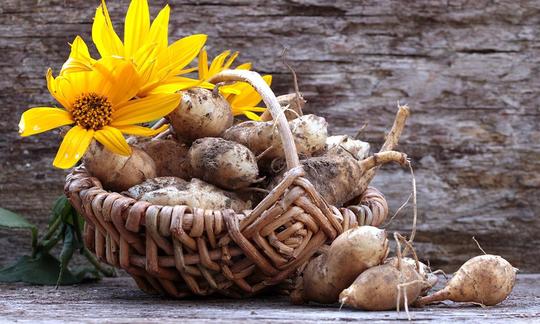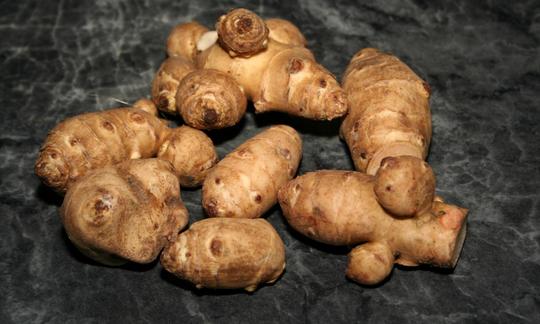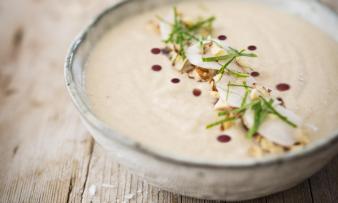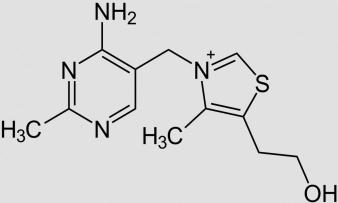Table of contents
Jerusalem artichoke ( Helianthus tuberosus) is a cultivated plant that is widespread throughout the world. Its raw, edible tubers are considered root vegetables. Jerusalem artichoke tubers have a watery consistency and taste like artichokes and yacón.
Use in the kitchen
Can you eat Jerusalem artichokes raw? Jerusalem artichokes, also known as Jerusalem artichokes or earth pears, have health benefits when eaten raw (and organically grown). However, eating inulin-rich vegetables such as Jerusalem artichokes can lead to flatulence. 3 If you don't tolerate Jerusalem artichokes raw, heating them briefly with lemon juice or vinegar (pH 4 or less) will reduce the inulin content. 9,17,19 In general, you should gradually increase the amount of this healthy root you eat.
The sweet, nutty tubers can be eaten with or without the skin. If you eat the delicate skin, you should opt for organic quality.
There are many different ways to prepare Jerusalem artichokes. Lightly steaming can enhance the artichoke-like taste. Jerusalem artichoke tubers can be used as chips, similar to potatoes. or fry or bake French fries (which is healthier), add to soups and make vegan casseroles, gratins, fritters or quiches.
Jerusalem artichokes are best eaten raw and finely grated or thinly sliced in salads; or you can experiment by simply adding a raw organic Jerusalem artichoke to one of our many salad recipes (eg: Satay salad with soba noodles and sugar snap peas ; Salad of seaweed, wild rice, tofu, sesame & spring onions ; Winter salad with red cabbage & grapefruit, Thai style). You can find another vegan recipe idea here: Raw Jerusalem artichoke and parsnip cream soup with hazelnut milk.
With a suitable juicer, you can extract fresh Jerusalem artichoke juice, which you can add to drinks.
Vegan recipe for a Jerusalem artichoke salad
Ingredients (for 2 people): 2 tablespoons orange juice, 1 tablespoon red wine vinegar, 1 teaspoon Dijon mustard, 150 g raw Jerusalem artichoke (organic), 250 g rocket, a handful of walnuts.
Preparation: First prepare the dressing. Mix the orange juice, red wine vinegar, Dijon mustard and a pinch of salt. Then cut the raw Jerusalem artichoke into thin slices. Finally, arrange the rocket together with the Jerusalem artichoke, spread the dressing over it and sprinkle the walnuts on the salad.
Tea preparation
: Pour half a litre of boiling water over around 3-5 fresh or dried Jerusalem artichoke blossoms and leave to steep overnight. Strain the tea and drink throughout the day.
Vegan recipes with Jerusalem artichoke can be found under the note: " Recipes that have the most of this ingredient ".
| Not only vegans or vegetarians should read this: Vegans often eat unhealthily. Avoidable nutritional errors. |
Purchasing - Storage
Jerusalem artichokes are in season from October to March. During this time, the tubers are often found in well-stocked supermarkets, organic shops, local weekly markets or directly from the producer. Jerusalem artichokes are available seasonally at major retailers such as Coop, Migros, Denner, Volg, Spar, Aldi, Lidl, Rewe, Edeka, Hofer and Billa ; organic supermarkets such as Denn's Biomarkt and Alnatura also stock this healthy root vegetable. Specialized suppliers also produce chips, dried strips or Jerusalem artichoke cubes, which are available all year round.
The availability of Jerusalem artichokes varies depending on the size of the store, catchment area, etc. Our recorded food prices for the DA-CH countries can be found above under the ingredient image - and by clicking you can see their development at various suppliers.
Storage tips
Jerusalem artichoke tubers wilt quickly and mold quickly if stored in damp conditions. If you grow your own, it's best to only take as much as you need and leave the rest in the ground. Alternatively, the tubers can be stored in earthen pits for up to six months. Storing them in a pot with soil is even easier. 4
Ingredients - Nutritional values - Calories
With 73 kcal/100g, Jerusalem artichokes are relatively low in calories. The tuber contains little protein (2 g/100g), carbohydrates (17.4 g/100g) and fats (0.01 g/100g). It consists of around 78% water. 2
Jerusalem artichoke contains significant amounts of B vitamins - especially vitamin B1 (thiamine: 0.2 mg/100g), similar to raw peas (0.27 mg). Significantly more thiamine is found in linseed (1.6 mg) or sunflower seeds (1.5 mg). 2
It also contains some vitamin C (4 mg/100g), comparable to an apple. However, compared to a peeled orange (53 mg/100g) or a yellow pepper (184 mg/100g), the vitamin C content is low. 2
Among the minerals, the potassium content (429 mg/100g) is particularly noteworthy. It is almost as high as in avocados (485 mg/100g). However, pistachios (1025 mg/100g) and hemp seeds (1200 mg/100g) contain significantly more. Jerusalem artichokes have a similar iron content (3.4 mg/100g) to cooked red lentils (3.3 mg/100g) and far more than beetroot, which is often touted as being rich in iron (0.8 mg/100g). However, puffed amaranth (7.6 mg/100g) and driedpumpkin seeds (8.8 mg/100g) contain far more iron. 2
In addition to bioactive phenolic compounds , there is plenty of fiber (inulin), which is why Jerusalem artichoke is very filling. 3 Inulin is a polysaccharide made of fructose monomers. 5,6 The root of chicory contains comparable amounts of inulin. 29
The complete ingredients of Jerusalem artichoke, the coverage of the daily requirement and comparison values with other ingredients can be found in our nutrient tables below the ingredient image.
Effects on health
Is Jerusalem artichoke healthy? Instead of starch, Jerusalem artichoke stores prebiotic inulin as a reserve substance. 5 This can stimulate the growth and activity of various types of bacteria in the intestine and thus have a positive effect on health. In adults, an increase in the number of bifidobacteria was observed when inulin was consumed. 5,12 Bifidobacteria produce acetate and lactate, which lowers the pH value, which in turn can reduce the growth of pathogens. 21
Humans cannot directly utilize dietary fiber. Therefore, these indigestible carbohydrates pass through the upper digestive tract and are only fermented by the bacterial flora in the intestine. Fermentation leads to several metabolic products, with short-chain fatty acids representing the main group. Short-chain fatty acids are necessary for the microbiome to keep the production of redox equivalents in the intestine in balance. 22 They also serve as an energy source for colonocytes (cells in the intestine). 26 As a result, short-chain fatty acids improve the integrity of the intestinal barrier, glucose and lipid metabolism; they regulate the immune system, inflammatory reactions and blood pressure. 23
Since the metabolism of inulin is independent of the insulin hormone, the blood sugar level remains relatively unaffected, which is why Jerusalem artichokes are suitable for diabetics. 20 This is why the tuber is popularly known as the 'diabetic potato'.
The positive effect of inulin on the human organism has been proven by clinical studies. The results show that Jerusalem artichoke lowers plasma glucose, total cholesterol and triglyceride levels. In addition to its prebiotic properties, Jerusalem artichoke can lower the intestinal pH value (in the gastrointestinal tract), which leads to a higher bioavailability of calcium, iron and magnesium. 20
For many people, weight control is a priority when it comes to nutrition and health. Therefore, the question is: Can Jerusalem artichoke help with weight loss? There are studies that have shown an appetite-regulating/appetite-suppressing effect. 3
Furthermore, Jerusalem artichoke contains salicylic acid, 1,27 which is known as the active ingredient in aspirin.
Secondary plant substances
Many of the health effects of Jerusalem artichoke can be attributed to the secondary plant substances it contains. Our article on secondary plant substances provides an overview of the classification of substance groups, their occurrence in foods and possible effects on humans. Jerusalem artichoke contains the following secondary plant substances, among others: 7,8,20
- Isoprenoids: diterpenes (kaurenic acid); triterpenes (feradiol, squalene), phytosterols (β-sitostenone); tetraterpenoids: carotenoids (β-carotene); sesquiterpenes (sesquiterpene lactones, β-bisabolene)
- Polyphenols: Phenolic acids: hydroxycinnamic acids (chlorogenic acid, isochlorogenic acid A and C, caffeic acid), flavonoids: flavonols (quercetin, quercetin-3-glucopyranoside); chalcones (3,4,2′-tri-hydroxychalcone4′-O-β-D-glucoside)
- Other organic compounds: phenylpropanoids (vanillin); isoprenoid aldehydes; alcohols (tyrosol)
However, it should be noted that the composition of the secondary plant substances in Jerusalem artichokes can vary depending on the variety, time of harvest and growing conditions. Therefore, quantities are only of limited use and should only be understood roughly.
In a study, the feradiol found in the flowers showed an inhibitory effect on the proliferation of colon cancer cell lines. Kaurenic acid and β-sitostenone have an antimicrobial effect on hospital germs such as Enterococcus faecium, which may be beneficial in the future as these germs are resistant to many antibiotics. 7
The content of the antioxidant pigment β-carotene in Jerusalem artichoke tubers is 34.7 mg/100g. 20
The sesquiterpene lactones isolated from the tuber show cytotoxic effects on cancer cell lines, especially breast cancer cells. These results underline the potential of Jerusalem artichoke as a valuable source of anticarcinogenic substances. 8,28
The leaves and tubers are used in traditional Chinese folk medicine to treat bone fractures, skin wounds and swelling. Medicinal baths made from leaves and stems promote healthy sleep and increase appetite. This is due, among other things, to the sesquiterpene β-bisabolene contained in the essential oil. It makes up up to 70% in tubers and leaves. 20
The total phenol content is highest in the leaves, followed by flowers and tubers and lowest in
Stem extracts. A variety of bioactive compounds were found in Jerusalem artichoke puree, including 25 polyphenolic substances with many health-promoting ingredients with antioxidant and anti-inflammatory properties. 8 The tubers of Jerusalem artichoke are rich in chlorogenic acid, and the leaves also contain the phenolic acids caffeic acid, isochlorogenic acid A and C, which have antidiabetic and wound-healing properties. 7, 14
Dangers - Intolerances - Side effects
Jerusalem artichoke dishes with a high proportion of the tuber can lead to flatulence and diarrhea. However, the reaction varies from person to person. On average, around 10-22 g of inulin is assumed per 100 g of Jerusalem artichoke; 25 you should not consume more than 40 g of inulin per day. 24 Consuming small amounts regularly is better than a lot at once.
Ecological footprint - animal welfare
Despite extensive research, we were unable to find any precise figures on the CO 2 footprint of Jerusalem artichokes. Jerusalem artichokes require little water and are considered to be less susceptible to pests and diseases. 4,14 It is also relatively easy to buy organic Jerusalem artichokes locally or to grow them yourself. The tuber also requires very little packaging for transport. It can therefore be assumed that regional Jerusalem artichokes have an excellent ecological balance, in addition to other advantages.
However, Jerusalem artichokes growing wild can also cause problems: they are not a native species in Europe, but they spread easily thanks to their resilient tubers. If they grow away from crops, Jerusalem artichokes can displace native species because they inhibit the growth of other plants. In addition, the dense foliage shades the ground and can therefore push back low-growing plants and reduce biodiversity. 30
In the field, however, planting Jerusalem artichokes can increase biodiversity in the soil. 18 Since Jerusalem artichokes are a very competitive plant, herbicides are only used in some conventional cultivation methods during the establishment of the plant. 31 Ideally, however, one should purchase organically grown tubers, as synthetic herbicides and pesticides are prohibited.
Research is currently being carried out into the use of Jerusalem artichokes for the production of biofuels. Land use and land use change play a major role here, and these should be kept as low as possible for sustainable biofuels. Jerusalem artichokes are proving to be a promising plant for this due to their growth requirements. 31
For detailed explanations of various sustainability indicators (such as ecological footprint, CO2 footprint, water footprint), see our article: What does the ecological footprint mean?
Animal protection - species protection
Jerusalem artichoke has soil-improving properties and thus has a positive effect on the edaphon (all living things in the soil). 15 In addition, the Jerusalem artichoke flowers provide food for insects very late in the autumn. Mice also enjoy the plant and eat the tubers.
Worldwide occurrence - cultivation
The Jerusalem artichoke is a neophyte in Europe. It originally comes from North Central America. It reached European soil at the beginning of the 17th century. 16,18
in the wild
Found Jerusalem artichokes are invasive. This means that Jerusalem artichokes can pose a problem for the native flora. 13,30 That is why you should not scatter the tubers carelessly and ensure that excess tubers and roots are disposed of properly.
Cultivation - Harvest
The tubers are planted in a similar way to potatoes. Jerusalem artichokes can be planted in autumn or spring. The tubers are placed 5-10 cm deep in the soil, at a distance of 60 x 50 cm. As Jerusalem artichokes are a potential weed, plant them outside the vegetable garden or at the edge of the garden. A little compost for fertilization is enough. If there is too much fertilizer, the plant invests in the herb and less in the tubers. This means that the easy-care plant can stay in the same place for several years. The tubers can be harvested all year round (the tubers are frost-resistant down to -30 °C), but it is best to do so at the end of October. 4 The American plant usually does not produce seeds in our latitudes.
Industrial production
Jerusalem artichoke is finding more and more uses in industrial processing. Applications include the production of bioethanol, the extraction of inulin, the production of fructose syrup and the use as an additive in functional foods and to improve the quality of food. 7,14
Further information
The Jerusalem artichoke ( Helianthus tuberosus) belongs to the sunflower genus ( Helianthus) and to the daisy family (Asteraceae). The plant reproduces via seeds and tubers. Seed production depends on many factors. Cultivation from seeds is therefore difficult, partly because of the strong dormancy of the seeds (seed dormancy). The tubers also serve as a storage organ for the plant. This allows the Jerusalem artichoke to survive the winter as a geophyte. During this time the tubers are not active (tuber dormancy). 18
Alternative names
In English, the name 'Jerusalem artichoke' or 'sunchoke' is common. In German-speaking countries, the plant is mainly called Topinambur (male or female according to Duden), Erdbirne or Jerusalem artichoke. The name Jerusalem artichoke is botanically incorrect: The plant neither comes from Jerusalem nor is it related to the artichoke. It is suspected that the Italian name 'girasole' resulted in the corruption of Jerusalem. 'Girasole' means sunflower and refers to the same genus ( Helianthus).
Other uses
Jerusalem artichokes are also good for our pets. However, tolerance can vary depending on the animal species - check with your veterinarian beforehand.
Bibliography - 29 Sources
| 1. | Fleischhauer SG, Guthmann J, Spiegelberger R. Essbare Wildpflanzen: 200 Arten bestimmen und verwenden. Baden: AT Verlag; 2014: 98. |
| 2. | US-Amerikanische Nährwertdatenbank USDA. 2019. |
| 3. | Hiel S, Bindels LB, Pachikian BD et al. Effects of a diet based on inulin-rich vegetables on gut health and nutritional behavior in healthy humans. The American journal of clinical nutrition. 2019;109(6):1683-1695. |
| 4. | Heistinger A. Handbuch Bio-Gemüse: Sortenvielfalt für den eigenen Garten. 7. Auflage. Innsbruck: Loewenzahn: 2020: 286-288. |
| 5. | Roberfroid MB. Introducing inulin-type fructans. British Journal of Nutrition. 2005;93(S1):13–25. |
| 6. | Gressner AM, Arndt T (Hrsg.). Lexikon der Medizinischen Laboratoriumsdiagnostik: Band 1: Klinische Chemie. 1. Auflage. Heidelberg: Springer Medizin Verlag. 2007: 669. |
| 7. | Méndez-Yáñez A, Ramos P, Morales-Quintana L. Human Health Benefits through Daily Consumption of Jerusalem Artichoke (Helianthus tuberosus L.) Tubers. Horticulturae. 2022;8(7):620. |
| 8. | Sawicka B, Krochmal-Marczak B (Hrsg). Jerusalem Artichoke Food Science and Technology: Helianthus Tuberosus. 1st ed. Singapore: Springer Nature Singapore; 2022: 116,118. |
| 9. | Lawson K. Modern Farmer Media Inc: Jerusalem Artichoke. Februar 2018. |
| 12. | Szewczyk A, Andres-Mach M et al. The Effect of a Diet Enriched with Jerusalem artichoke, Inulin, and "Fluox" on Cognitive Functions, Neurogenesis, and the Composition of the Intestinal Microbiota in Mice. Curr Issues Mol Biol. 2023;45(3):2561–2579. |
| 13. | Filep R, Balogh L et al. Helianthus tuberosus L. agg. in the Carpathian Basin: a blessing or a curse? Genet Resour Crop Evol. 2018; 65(3):865–879. |
| 14. | Yang L, He QS et al. The prospects of Jerusalem artichoke in functional food ingredients and bioenergy production. Biotechnol Rep. 2015;5:77–88. |
| 15. | Shao T, Gu X et al. Industrial crop Jerusalem artichoke restored coastal saline soil quality by reducing salt and increasing diversity of bacterial community. Applied Soil Ecology. 2019; 138:195–206. |
| 16. | Lieberei R, Reisdorff C. Nutzpflanzenkunde: neu bearbeitet. 7. Auflage. Stuttgart: Georg Thieme Verlag; 2007: 113. |
| 17. | Takeuchi J, Nagashima T. Preparation of dried chips from Jerusalem artichoke (Helianthus tuberosus) tubers and analysis of their functional properties. Food Chemistry. 2011; 126(3):922–926. |
| 18. | Kays SJ. Biology and Chemistry of Jerusalem Artichoke: Helianthus Tuberosus L. 1. Auflage. Baton Rouge: Taylor & Francis Group; 2008. |
| 19. | Glibowski P, Bukowska A. The effect of pH, temperature and heating time on inulin chemical stability. Acta Scientiarum Polonorum Technologia Alimentaria. 2011; 10(2):189–196. |
| 20. | Sawicka B, Skiba D et al. Jerusalem artichoke (Helianthus tuberosus L.) as a medicinal plant and its natural products. Cell Mol Biol (Noisy-le-grand) 2020; 66(4):160–177. |
| 21. | Modler HW. Bifidogenic factors—sources, metabolism and applications. International Dairy Journal. January 1994;4(5):383–407. |
| 22. | den Besten G, van Eunen K et al. The role of short-chain fatty acids in the interplay between diet, gut microbiota, and host energy metabolism. Journal of Lipid Research. September 2013;54(9):2325–2340. |
| 23. | Nogal A, Valdes AM, Menni C. The role of short-chain fatty acids in the interplay between gut microbiota and diet in cardio-metabolic health. Gut Microbes. 2021;13(1):1897212. |
| 24. | U.S. Food and Drug Administration. GRAS Notification - lnulin from Jerusalem Artichoke. 2018: 30. |
| 25. | Rubel IA, Iraporda C et al. Inulin from Jerusalem artichoke (Helianthus tuberosus L.): From its biosynthesis to its application as bioactive ingredient. Bioactive Carbohydrates and Dietary Fibre. November 2021;26:100281. |
| 26. | Nogal A, Valdes AM, Menni C. The role of short-chain fatty acids in the interplay between gut microbiota and diet in cardio-metabolic health. Gut Microbes. 1. Januar 2021;13(1):1897212. |
| 27. | Wu J, Qian Y et al. Separation and identification of phenolic compounds in canned artichoke by LC/DAD/ESI-MS using core–shell C18 column: A comparative study. Journal of Chromatography B. May 2013;927:173–80. |
| 28. | Yuan X, Cheng M et al. Cytotoxic constituents from the leaves of Jerusalem artichoke (Helianthus tuberosus L.) and their structure–activity relationships. Phytochemistry Letters. Februar 2013;6(1):21–25. |
| 29. | Rendondo-Cuenca A, Herrera-Vàzquez SE et al. Inulin extraction from common inulin-containing plant sources. Industrial Crops & Products. 2021/Oktober; 170:113726. |
| 30. | Infoflora.ch Topinambur (Korbblütler). Helianthus tuberosus L. (Asteraceae). 2023. |
| 31. | Rossini F, Provenzano ME et al. Jerusalem Artichoke (Helianthus tuberosus L.): A Versatile and Sustainable Crop for Renewable Energy Production in Europe. Agronomy 528. 2019. |











Comments